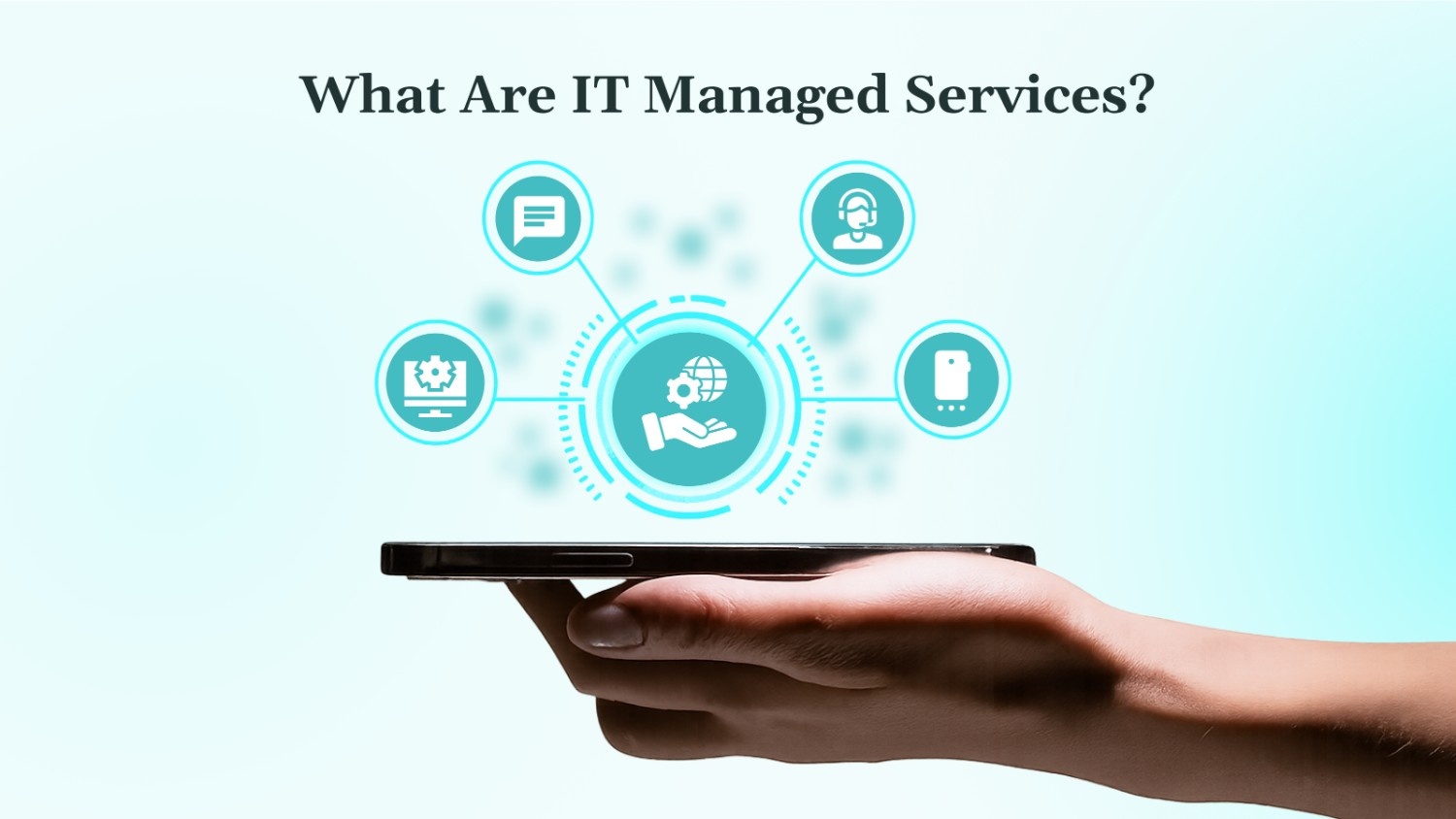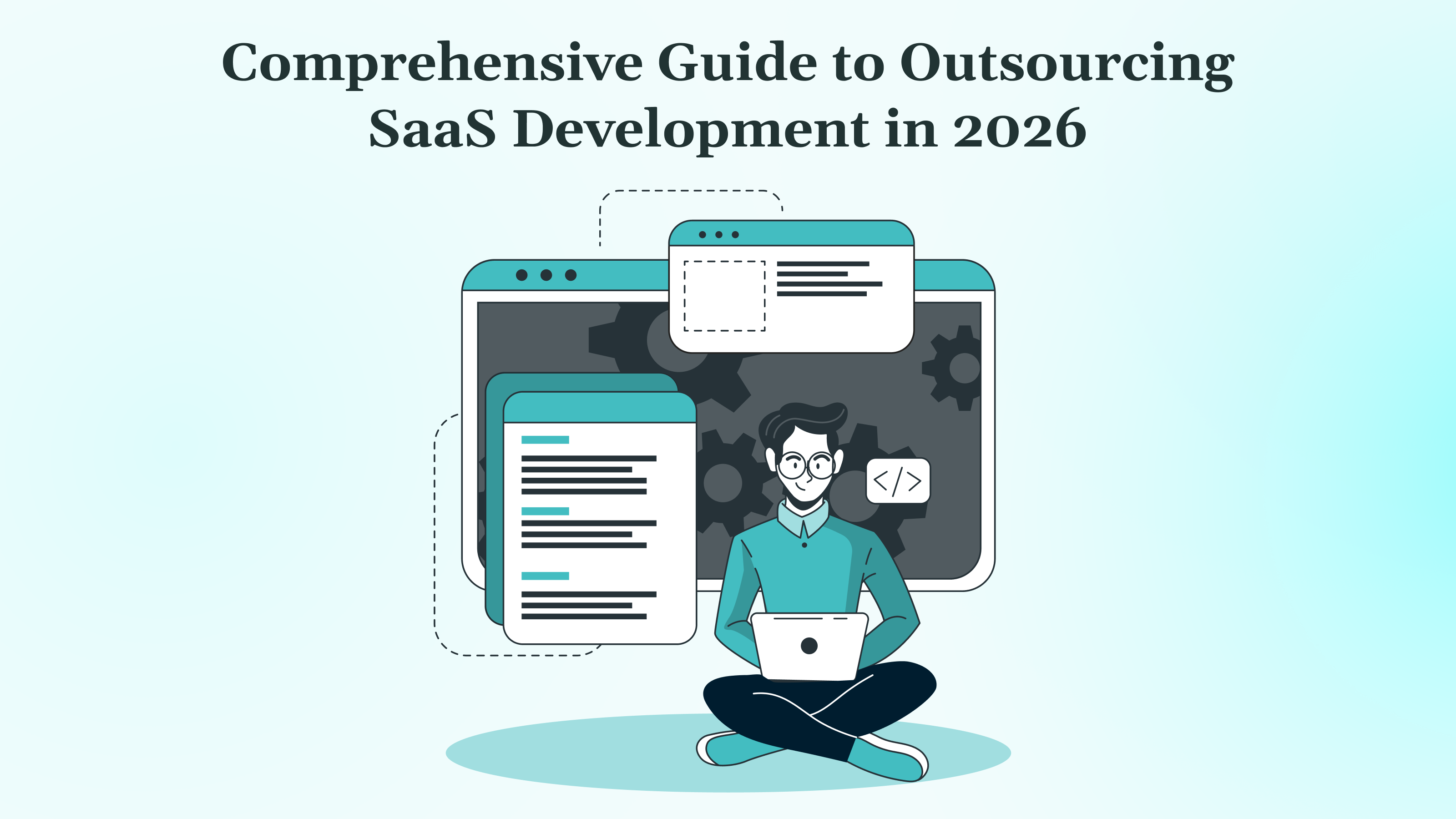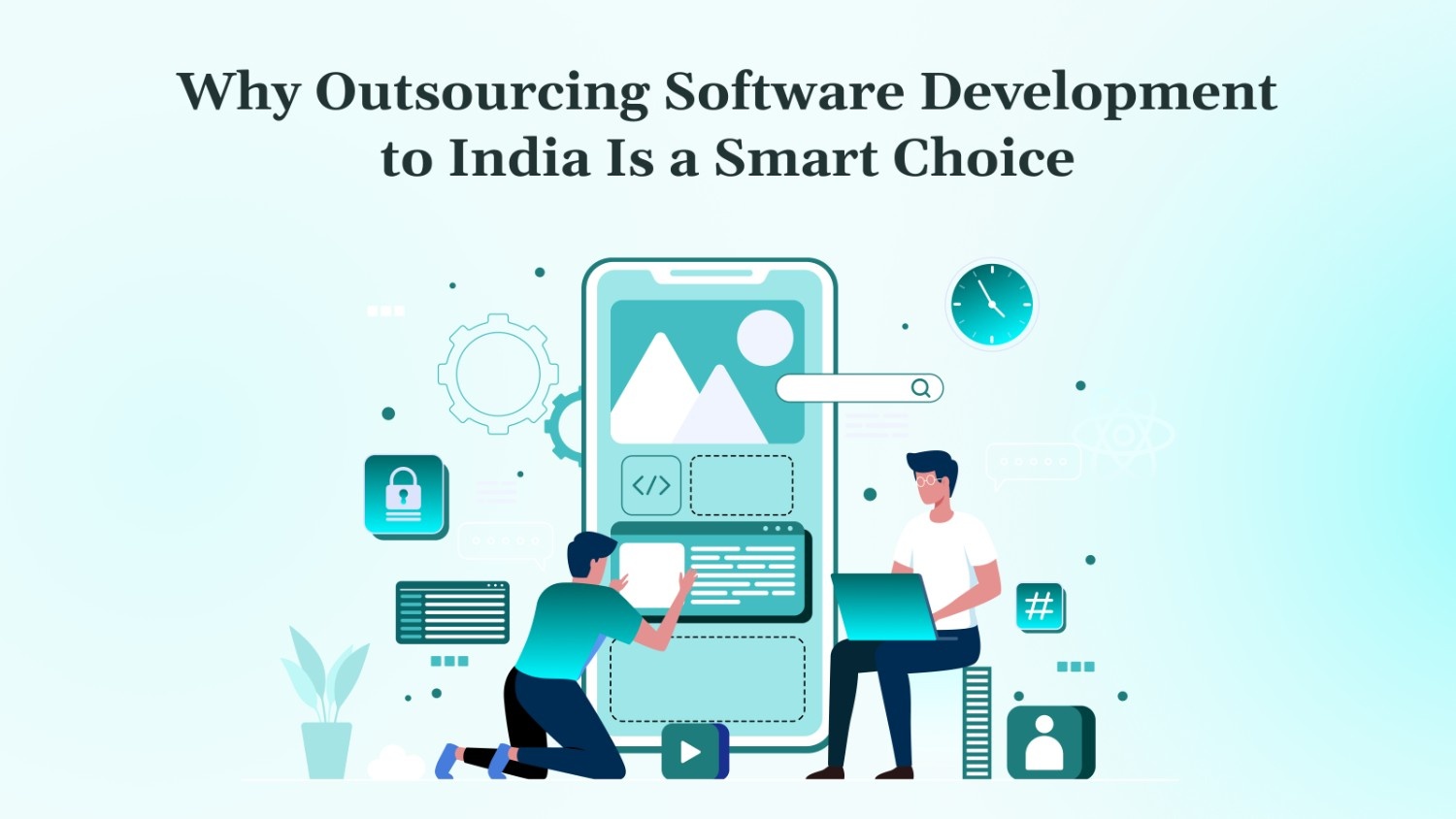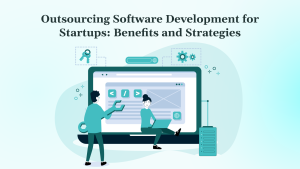Managing IT in-house can be overwhelming for businesses. As technology advances, staying updated with everything from network security to data backups can stretch internal resources thin. That is where managed IT services come in.
Instead of handling everything internally, businesses are increasingly delegating their IT responsibilities to specialized service providers. This not only reduces the burden on in-house teams but also ensures that systems are continually monitored, secure, and optimized by experts.
But what exactly are managed IT services, and how can they benefit your organization? This blog will explore the core concepts of managed IT services, the various types available, the advantages they provide, and the obstacles businesses might encounter.
Key Takeaways
- Managed IT services offer businesses continuous monitoring, expert management, and optimized IT infrastructure, minimizing downtime and enhancing security.
- By outsourcing IT management, businesses can reduce internal costs, avoid unexpected expenses, and focus on strategic goals while experts handle day-to-day IT tasks.
- Common types of managed IT services include network monitoring, cybersecurity, data backup, cloud management, and help desk support, each tailored to meet business needs.
- When selecting an MSP, businesses should evaluate their experience, certifications, and flexibility to ensure the provider aligns with specific business goals and can scale as needed. DEVtrust offers tailored solutions to optimize your IT services.
What Are Managed IT Services?
Managed IT services refer to the practice of outsourcing the responsibility for maintaining, managing, and supporting an organization’s IT infrastructure and end-user systems to a third-party service provider, known as a Managed Service Provider (MSP).
This approach allows businesses to offload routine IT duties like network surveillance, data storage, cybersecurity, and help desk support, ensuring that their IT systems are continuously optimized and secure.
Instead of waiting for issues to occur and responding afterward, managed IT services are built around a proactive approach, where MSPs actively monitor systems, detect issues early, and implement solutions before any major disruptions occur.
This service model is often subscription-based, offering businesses predictable costs and continuous, expert-level support without the need for in-house IT teams to manage everything.
Key Benefits of Managed IT Services
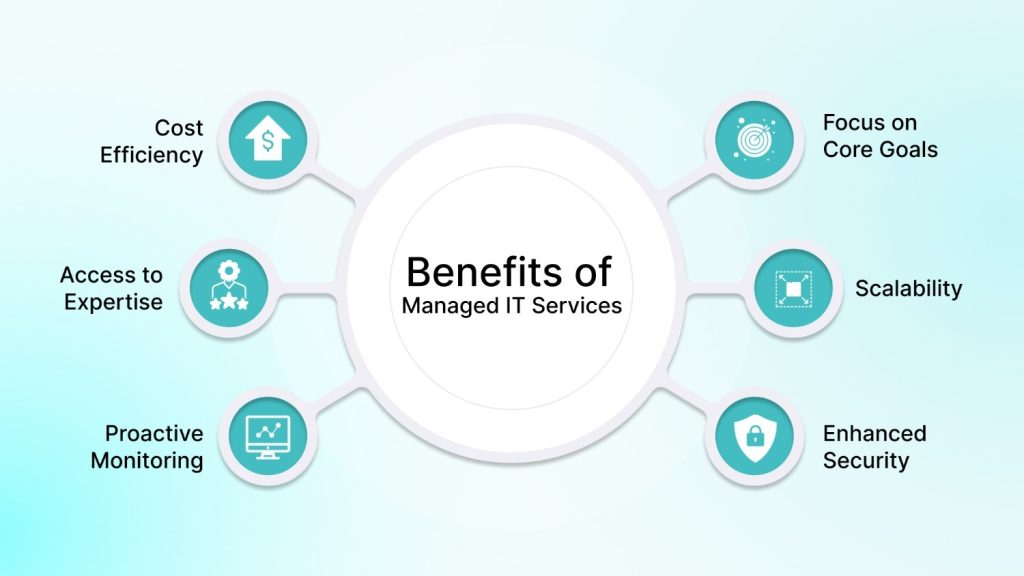
1. Cost Efficiency
Predictable, fixed pricing helps businesses reduce internal IT costs, avoiding unexpected expenses tied to staff, training, and technology upgrades.
2. Access to Expertise
Gain access to skilled professionals in areas like cybersecurity and cloud management, without the overhead of hiring in-house experts.
3. Proactive Monitoring
24/7 system monitoring ensures potential issues are addressed before they cause disruptions, minimizing downtime.
4. Enhanced Security
Comprehensive security measures, including real-time threat detection and regular updates, keep data and systems safe from evolving cyber threats.
5. Scalability
Effortlessly adjust IT services as your business expands, whether adding new devices or expanding cloud infrastructure, without major investments.
6. Focus on Core Goals
By outsourcing IT management, your team can concentrate on strategic business priorities, while experts handle day-to-day IT tasks.
If you are looking for custom solutions tailored to your IT needs, DEVtrust specializes in full-stack product development, API integrations, and scalable cloud architecture that can enhance your managed IT services. Book a call now.
With a clear understanding of the benefits of managed IT services, it is important to know how they differ from other IT solutions, especially cloud services. Let us explore the distinction between managed IT services and cloud services to clarify how each supports your business needs.
What is the Difference Between Managed IT Services and Cloud Services?
Managed IT services and cloud services are frequently mentioned together, but they serve different functions and have distinct characteristics. Here is a breakdown of their key differences:
| Aspect | Managed IT Services | Cloud Services |
| Definition | Outsourcing IT functions for proactive management and support. | Delivering computing resources (e.g., IaaS, PaaS, SaaS) over the internet. |
| Scope | Comprehensive management of both on-premise and cloud resources. | Primarily focused on providing scalable infrastructure and applications over the cloud. |
| Focus | Security, performance, support, and ongoing management. | Scalability, flexibility, and cost efficiency of cloud resources. |
| Management | Managed by third-party providers, covering both infrastructure and workloads. | Managed by cloud service providers, focusing on infrastructure only. |
| Pricing | Typically subscription-based, offering fixed pricing models. | Pay-as-you-go or subscription-based, depending on usage. |
| Customization | Can be highly customized to meet specific business needs. | Offers a range of pre-configured services but can be customized based on resource requirements. |
| Security Responsibility | MSPs handle security and system protection. | Security is shared between the provider (for infrastructure) and the client (for their data). |
| Access | Access to both on-premise and cloud-based resources. | Accessible over the internet, often via cloud portals or interfaces. |
The key distinction is that managed IT services are broader in scope, focusing on the continuous management, security, and maintenance of both on-premise and cloud-based systems. Cloud services, on the other hand, primarily focus on providing remote computing resources, where the management of workloads remains the responsibility of the client.
10 Types of Managed IT Services
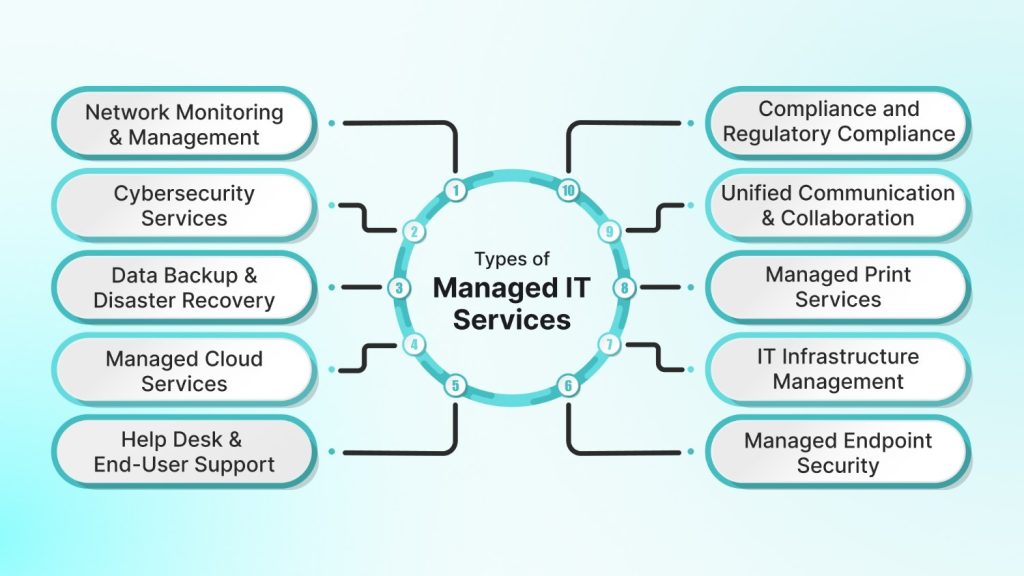
Managed IT services vary depending on the unique needs of a business. Whether it is ensuring the security of data, optimizing network performance, or managing cloud infrastructure, MSPs offer tailored services that provide both operational and strategic value.
Each service is typically delivered on a proactive, subscription-based model that allows businesses to plan for predictable costs while gaining access to industry-leading expertise. Below are the most common types of managed IT services:
1. Network Monitoring and Management
Network performance is crucial to the efficiency of any business. Managed network services involve constant monitoring to ensure systems are up and running smoothly. MSPs track everything from internet bandwidth and server performance to network security, proactively detecting and addressing any issues that could disrupt operations.
Benefits:
- Continuous monitoring of network performance.
- Reduced downtime and disruption to business operations.
2. Cybersecurity Services
Managed cybersecurity services help organizations safeguard sensitive data and prevent cyberattacks. MSPs provide threat monitoring, vulnerability management, incident response, and real-time security assessments to keep your systems secure.
Benefits:
- Protection against evolving threats like ransomware, phishing, and data breaches.
- Expert guidance to ensure compliance with industry-specific regulations (GDPR, HIPAA, etc.).
3. Data Backup and Disaster Recovery
Managed backup and disaster recovery services ensure that critical data is consistently backed up and can be quickly restored in the event of a cyberattack, technical failure, or natural disaster. MSPs implement regular, automated backups and recovery strategies, allowing businesses to recover from setbacks with minimal downtime.
Benefits:
- Automated, secure data backups with off-site or cloud-based storage.
- Protection against data loss caused by disasters, both digital and physical.
4. Managed Cloud Services
With the increasing reliance on cloud technologies, managing and optimizing cloud infrastructure has become a critical function. Managed cloud services include cloud migration, cloud management, and cloud security services. MSPs assist businesses in navigating multi-cloud or hybrid environments, ensuring data is secure, costs are optimized, and cloud infrastructure is performing at its best.
Benefits:
- Enhanced security for cloud-based systems and data.
- Cost optimization through proper cloud resource management.
5. Help Desk and End-User Support
Managed help desk services offer users fast, reliable support when problems arise. MSPs handle everything from password resets to troubleshooting software and hardware issues, providing employees with the support they need to stay productive. This service can be delivered remotely or on-site, depending on the needs of the business.
Benefits:
- 24/7 support for technical issues, reducing downtime.
- Faster resolution of common IT problems.
6. Managed Endpoint Security
With the increasing use of personal devices, securing every point of access to your company’s network has never been more important. Managed endpoint security protects all devices, such as desktops, laptops, and mobile devices, from cyber threats. MSPs install and maintain anti-virus software, firewalls, and encryption tools, ensuring that devices remain secure no matter where they are used.
Benefits:
- Continuous monitoring and protection for all company devices.
- Ensures secure access to internal networks and systems.
7. IT Infrastructure Management
This service involves managing the physical and virtual components of your IT infrastructure, including servers, storage, and networking equipment. MSPs ensure your IT infrastructure is optimized, secure, and compliant with industry regulations, while also offering design and deployment services to support business growth.
Benefits:
- Ensures compliance with industry regulations.
- Managed setup, deployment, and ongoing management.
8. Managed Print Services
Many businesses overlook the complexity and costs associated with managing printers and copiers. Managed print services streamline print operations by managing devices, monitoring print usage, optimizing print workflows, and replenishing supplies. This service helps reduce printing costs and improve document management.
Benefits:
- Optimized print workflow.
- Better document security and management.
9. Unified Communications and Collaboration (UCC)
Effective communication is critical to business success. Managed UCC services help businesses optimize and manage their communication systems, including voice-over IP (VoIP), video conferencing, instant messaging, and email systems. MSPs ensure that these communication tools are secure, reliable, and integrated with existing IT systems.
Benefits:
- Improved communication and collaboration across teams.
- Enhanced productivity and employee engagement.
10. Compliance and Regulatory Compliance
For businesses operating in regulated industries, staying compliant with industry standards and data protection laws (e.g., GDPR, HIPAA, PCI DSS) is essential. Managed compliance services ensure that businesses meet regulatory requirements by implementing security measures, conducting audits, and providing ongoing support.
Benefits:
- Assurance of meeting regulatory requirements.
- Reduced risk of compliance violations and penalties.
While there are many types of managed IT services to choose from, businesses may also face challenges when outsourcing their IT needs. Let us take a look at some of the common challenges and how they can be addressed to ensure a smooth partnership with your MSP.
Challenges of Managed IT Services and Their Solutions
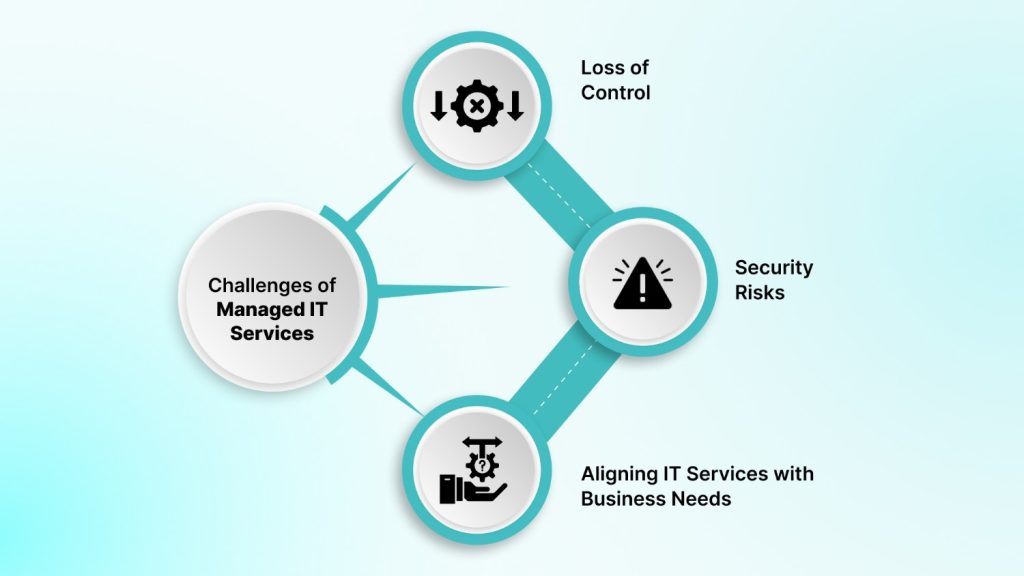
While managed IT services offer numerous benefits, businesses should be aware of the challenges they may face when outsourcing their IT functions. Recognizing these challenges enables businesses to make well-informed choices regarding selecting the right MSP and ensuring a smooth partnership.
1. Loss of Control
Outsourcing IT management to an MSP can sometimes lead to a perceived loss of control. Companies might feel detached from the daily decisions and management of their IT systems.
Solution: To mitigate this, it is essential to establish clear communication channels, set measurable goals in Service Level Agreements (SLAs), and regularly review performance to ensure the provider is meeting expectations.
2. Security Risks
Sharing sensitive data with an external provider can cause security concerns, particularly in safeguarding valuable business information from breaches. Despite an MSP’s robust security measures, the risk of cyberattacks or data leaks remains.
Solution: Businesses should ensure that the MSP follows industry best practices for data security and compliance. It is crucial to choose an MSP that adheres to recognized security standards and undergoes regular audits.
3. Aligning IT Services with Business Needs
If the MSP does not fully understand a business’s unique challenges or long-term goals, the services provided may not align well with the company’s needs. This can lead to inefficiencies or missed opportunities.
Solution: To address this, businesses should communicate their specific IT needs and business goals upfront. Choosing an MSP with industry-specific experience and ensuring ongoing dialogue will help tailor services to meet the evolving demands of the business.
Choosing the Right Managed IT Service Provider
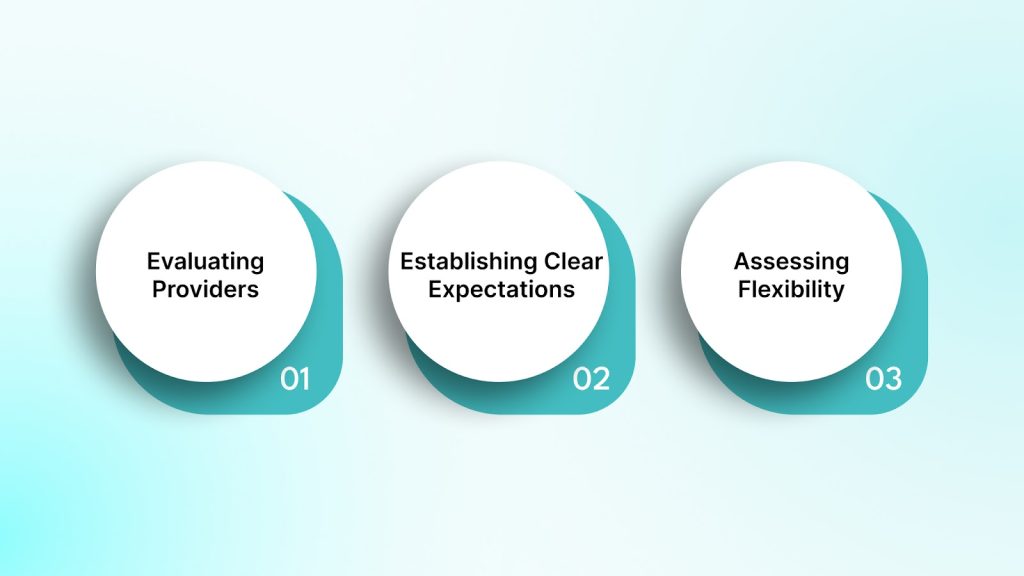
Choosing the right Managed Service Provider (MSP) is essential for businesses to get the maximum benefit from their IT services. To make an informed decision, you need to carefully evaluate potential providers and ensure they meet your business needs. Here is how to choose the right MSP:
1. Evaluating Providers
Start by evaluating the provider’s experience and expertise. Look for an MSP that understands your specific industry and has a proven track record in managing the IT functions you need. This ensures that the provider can handle your infrastructure and meet your security, compliance, and operational needs effectively.
Key considerations when evaluating providers:
- Industry experience: Ensure they have worked with businesses similar to yours or in your industry.
- Certifications: Look for relevant certifications like ISO 27001 (for security) or industry-specific certifications that ensure high standards.
- Customer reviews: Check for testimonials or case studies from businesses in your sector to understand how they performed in real-world scenarios.
- Service offerings: Make sure their services match the needs of your business, whether it is cloud management, cybersecurity, or help desk support.
2. Establishing Clear Expectations
Once you have identified a few potential MSPs, it is time to set clear expectations. This helps avoid misunderstandings and ensures that both parties know what is expected. A well-drafted Service Level Agreement (SLA) will serve as the foundation for this relationship.
What to include in your SLA:
- Scope of services: List all services the MSP will provide, including specific tasks such as network monitoring, backups, and help desk support.
- Performance metrics: Define clear performance standards, such as uptime guarantees, response times for support requests, and resolution times for issues.
- Regular reporting: Request monthly or quarterly reports on system performance, security assessments, and compliance to monitor how well the MSP is meeting expectations.
- Penalties for non-performance: Include consequences if the provider fails to meet agreed-upon service levels.
3. Assessing Flexibility and Scalability
Your IT needs will grow and evolve over time, so it is important to choose an MSP that can scale with your business. Make sure the MSP can accommodate changes in your technology requirements as your company expands.
Consider these factors when assessing scalability:
- Capacity for growth: Can the MSP handle increasing data storage, new applications, or more complex IT systems as your business grows?
- Support for emerging technologies: Ask about their ability to support advanced technologies (like AI, cloud, or hybrid environments) that may become important for your business in the future.
Pricing is a major factor in the decision-making process. Let us now explore the different pricing models used for managed IT services, and how you can make an informed decision to ensure your IT budget is aligned with your business goals.
Managed IT Services Pricing Strategies
Understanding the pricing models for managed IT services is crucial for businesses aiming to align their IT expenditures with their operational needs and budget. Here is an overview of the most common pricing strategies:
1. Subscription Models: Per-Device, Per-User, and Tiered Pricing
- Per-Device Pricing: Businesses are charged a flat monthly fee for each device managed, such as desktops, servers, or network printers.
- Per-User Pricing: This model charges a fixed monthly fee per user, irrespective of the number of devices they utilize. It is ideal for businesses with a consistent number of users and can simplify budgeting.
- Tiered Pricing: Service packages are offered at different levels (e.g., Basic, Advanced, Premium), with each tier providing a set of services at a corresponding price point. This allows businesses to choose a package that best fits their needs and budget.
2. À la Carte and Value-Based Pricing Options
- À la Carte Pricing: Clients select and pay for only the specific services they require, such as data backup or cybersecurity. This model offers flexibility but may lead to higher costs if multiple services are needed.
- Value-Based Pricing: Pricing is based on the perceived value of the services to the client, rather than the cost of providing them. This approach can result in increased profit margins for providers and more tailored solutions for clients.
Making informed decisions about which pricing model to adopt can significantly impact a business’s profitability. For instance, while per-user pricing offers predictability, it may not be cost-effective for businesses with a high number of devices per user. Conversely, à la carte pricing provides flexibility but can lead to higher overall costs if multiple services are needed.
Conclusion
Choosing managed IT services can significantly improve your business’s operational efficiency, security, and scalability. By outsourcing IT management to experts, you allow your internal team to focus on growth, innovation, and delivering value to customers, while the heavy lifting of maintaining and securing IT systems is handled by professionals.
At DEVtrust, we provide a full suite of Managed IT Services, including network monitoring, cybersecurity, cloud architecture, and API integrations. Our services are designed to ensure your IT infrastructure is optimized, secure, and aligned with your business goals.Talk to our experts about scaling your IT operations. Whether you need enhanced security, cloud solutions, or full-stack management, we have the expertise to help.
What Are IT Managed Services? Types and Benefits
Enhance business efficiency with Managed IT Services. Explore types, benefits, and how outsourcing IT can improve security and optimize operations.
Contact Us